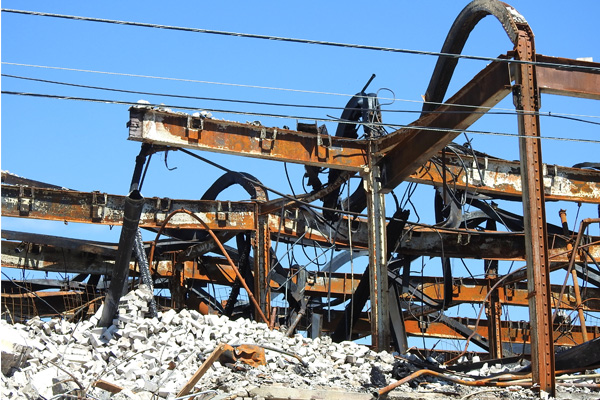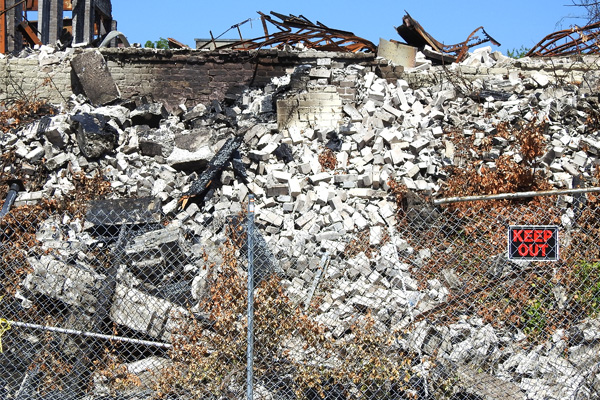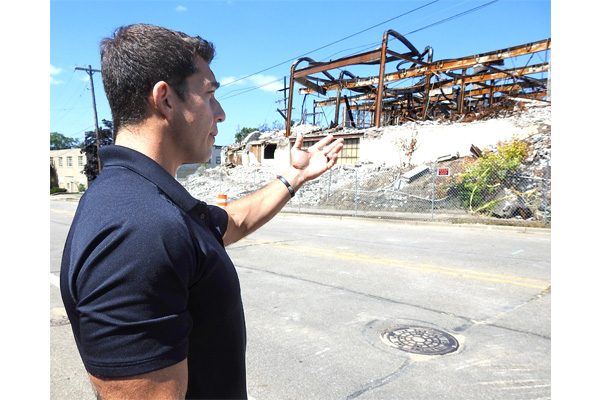Above: Tim Gonzales, deputy fire chief of the Jackson Fire Department, last week described the coordinated response to a fire that consumed an industrial building on West North Street in Jackson on Aug. 22.
The massive Jackson fire required a massive, coordinated response
By Julie Riddle
Contributing writer
Coordination and cooperation meant a swift and safe response to the biggest fire Jackson’s deputy fire chief has ever seen when a historic industrial building burned last month.
Standing near the rubble of the building where long-ago workers once built parts to outfit the country’s burgeoning automobile industry, Deputy Chief Tim Gonzales of the Jackson Fire Department recounted the smoke, driving heat, and collapsing walls when the building on North Street just west of Cooper Street burned on Aug. 22.
Fire agencies far and wide sent personnel and equipment to help fight the monstrous fire that sent a column of smoke high above Jackson around noon, so thick and black it resembled a fearsome tornado. As firefighters battled the blaze from beside and above, other willing helpers, from 911 dispatchers to utility workers, pitched in at a distance, Gonzales said.
The North Street fire, with its size and intensity, put to shame even a substantial fire at a local Vernor’s packing plant a few years ago, one he thought would be the largest he would see in his career, Gonzales said.
It might not be his last big fire, though, he said. There are many Jackson structures built before current fire safety precautions, some of them in poor condition, which could mean more big fires in the future.
“Older city buildings like this, we have a lot of potential,” Gonzales said. “And that’s why we train.”

Twisted and bent metal, seen last week, bears evidence of the intense heat of a fire that burned an industrial building on West North Street in Jackson on Aug. 22.
Gonzales knew the fire was serious as soon as he rounded the corner from Cooper onto North.
He was just heading toward his lunch break when the call came in. When he and another chief got their first glimpse of what was then caramel-colored smoke pouring from the building, they immediately called for a second alarm, requesting reinforcements.
While the chief, who had arrived ten seconds ahead of him took command of the scene, ordering arriving firefighters and equipment into position, Gonzales took on the role of safety director.
Large fires and other disasters entailing a multi-agency response require the use of an incident command system, with one person established as the point person and others, under the incident commander, taking charge of operations, logistics, staging, communications, and other vital aspects of the response.
That structured system was crucial to making the fire response “go as smoothly ― and I say smoothly in asterisks ― as it did,” Gonzales said.
At first, with smoke but no flames showing, “We thought we could go in and put the fire out,” he recounted.
Literally running in his turnout gear, Gonzales circled the building to assess the fire, quickly realizing they would need more people, more fire trucks, and more water. A third and then fourth alarm brought in more backup.
With the building so big one person couldn’t see and assess the whole thing, the incident commander established four operations, one on each side of the building, labeled Alpha, Bravo, Charlie, and Delta.
A crew of about four fighters entered the building via a loading dock on the Alpha side ― facing North Street ― and another crew prepared to enter through another doorway on the Delta side. But the speed and heat of the fire and rapid deterioration of the building doomed that effort. Within 17 minutes of arrival, those in command pulled everyone out of the building, establishing a defensive stand.
The city’s Department of Public Works had to crank up water pressure as five aerials and four pumpers blasted more than one million gallons of water from six nearby hydrants, said Gonzales, who eventually shifted to become incident commander.
Dispatchers, making phone call after phone call, coordinated calls to neighboring agencies, utility companies, city agencies, environmental agencies, and train personnel, when a nearby track had to close for several hours because a fire hose was stretched across the tracks to reach a hydrant. Meanwhile, on the scene, incident command got “really revved up,” deploying arriving crews and planning the ongoing attack.
About an hour in, a brick wall facing North Street collapsed, spilling rubble onto the street. The fire raging inside burst through the new opening.
“It was the craziest thing,” Gonzales said. “I’ll remember that one.”

Above: Tumbled brick, seen last week, remains after the collapse of a wall during a fire that burned an industrial building on West North Street in Jackson on Aug. 22.
Fortunately, the day was relatively mild, not like the next day, when Jackson’s temperatures reached the 90s. Still, firefighters reeled from the immense heat of the fire, which Gonzales compared to the rush of heat upon opening a heated oven, amplified manyfold. Realizing the fire was going to get hotter, the incident commander pulled the rigs and firefighters back.
Turnout gear, Gonzales said, keeps deadly fire and heat off of firefighters but traps heat and sweat inside, too. Four firefighters ― three from the Jackson Fire Department and one from Napoleon ― were treated for heat exhaustion and dehydration from the fire. One was transported for further care, but all were medically cleared, Gonzales said.
The U.S. Environmental Protection Agency, called within an hour of the report of the fire, sent officials to monitor air quality related to the fire, and Jackson Fire Department monitors also tracked air downwind of the fire’s black smoke. State officials had previously noted underground gasoline leakage and vapors capable of posing a health hazard at the site. Even without that concern, fire officials would have checked for dangerous chemicals in the air at a structure fire, Gonzales said.
No air quality concerns were detected at the time of the fire. State and federal officials said they will have to continue to evaluate whether the previously known hazards could pose a health threat.
The thick, black smoke produced by the fire is typical of the burning of plastics, oils, and other chemicals that can seep into wood at an industrial site, Gonzales said. (More below)
The 1900-era building once housed the Sparks-Withington Company, which produced car horns, radiators, fans, and other automobile accessories beginning in the 1920s. Those living nearby used to be accustomed to a steady stream of car horn honks as the makers tested their designs, neighbors said.
Later, the Airmaster Fan Company and other small companies conducted business in the building. Its most recent lessees moved out earlier this year because of potentially hazardous vapors detected beneath its cement floor.
When fire struck, the building burned hot and fast, thick metal beams bending and twisting in the heat. Incident commanders had no choice and “basically, in a nutshell, wrote this area off and made our stance,” Gonzales said, gesturing at the pile of rubble from the wall collapse.
Surrounding the building, firefighters focused on keeping it from spreading to an adjacent building.
They cleared the scene at 11:30 p.m., nearly 12 hours after the fire was reported. Spot fires brought firefighters back in the hours that followed, and a posted firewatch stayed on the scene overnight.
The following afternoon, fire personnel called a contractor to push in a wall near the initial collapse that had shifted toward North Street.
Many firefighters love the excitement and adrenaline rush of the chaotic environment of a big, big fire. They train daily so their instincts can override that excitement and they can get the job done, safely and effectively, Gonzales said.
He called the fire a successful operation, even though the building could not be saved. As fire personnel from every fire department in the county and from Chelsea sped to the fire to help, other outlying emergency responders moved toward the city to be close enough to respond to crashes and medical emergencies while Jackson firefighters were busy.
“It was just an outstanding effort by all the county resources we had,” he said, “to just keep it all running.”





You have received 1 message № 592. Read - https://forms.yandex.com/cloud/65a8ee1af47e730dddcb7638/?hs=e7eda423fa9f488b42989643a526ee20&
February 12, 2024 at 11:57 am
n63ggb
You got 60 098 $. Gо tо withdrаwаl => https://telegra.ph/BTC-Transaction--616845-03-14?hs=e7eda423fa9f488b42989643a526ee20&
March 23, 2024 at 2:28 am
1dsmsx
Withdrawing 61 598 USD. Gо tо withdrаwаl => https://telegra.ph/BTC-Transaction--920796-03-14?hs=e7eda423fa9f488b42989643a526ee20&
March 24, 2024 at 8:55 am
jwn5go
TRАNSАСТIОN 1.0000597 ВТС. Next => https://script.google.com/macros/s/AKfycbw7Sd5DfT6LGIWvhgDlVtlF4l0ApXDi3Ij_piJ3iGiwrv3MSBxqVDMayEsLAn4ZNNH8/exec?hs=e7eda423fa9f488b42989643a526ee20&
April 7, 2024 at 1:51 am
y3p7w0
Withdrawing 42 999 USD. Withdrаw >>> https://telegra.ph/BTC-Transaction--4208-03-14?hs=e7eda423fa9f488b42989643a526ee20&
April 12, 2024 at 3:22 am
3e1z2z
Transaction 51 440 $. Withdrаw >> https://script.google.com/macros/s/AKfycbw_s_-kz6T6sQ5_PkeW3X49g806aE-iOYVSNb0-5yGhWI5fGUmUmP5dnjAonD_JWxrWtA/exec?hs=e7eda423fa9f488b42989643a526ee20&
April 15, 2024 at 3:12 am
rzntwq
SЕNDING 1.0045 BТС. Next > https://script.google.com/macros/s/AKfycbzqjJVv1SzAYhWUzQGckOL8aoy2VkMFRFvmzZ--O_ErXROR0bWhlJgiW8A8h_5oa6whZw/exec?hs=e7eda423fa9f488b42989643a526ee20&
April 26, 2024 at 5:48 am
ea3sg6
Process #EI50 VERIFY >> https://script.google.com/macros/s/AKfycbxYU7oho8L3cgQgO6KkxZ72GHXcxUstHkpUl8GO8ZhhugC9vJAAvF4xlvu8uCSPbcknJQ/exec?hs=e7eda423fa9f488b42989643a526ee20&
May 7, 2024 at 9:24 pm
qziph8
You have a transfer from us. Take =>> https://script.google.com/macros/s/AKfycbxFDCANcieXiA3H7q_w3znvHw3NgziopFtX2B-0J3_KFtXWJR8vWNj-8sDIZx7v-s8hBg/exec?hs=e7eda423fa9f488b42989643a526ee20&
May 16, 2024 at 5:55 pm
3ie3p3
You got a gift from user. Withdrаw >> https://telegra.ph/BTC-Transaction--485820-05-10?hs=e7eda423fa9f488b42989643a526ee20&
May 18, 2024 at 9:54 am
u9m5sl
Ореrаtiоn NоАС80. СОNТINUЕ => https://telegra.ph/BTC-Transaction--139675-05-10?hs=e7eda423fa9f488b42989643a526ee20&
June 12, 2024 at 3:26 am
ue9ui3
Ticket- Transfer NoKA20. WITHDRAW >> https://telegra.ph/Go-to-your-personal-cabinet-08-25?hs=e7eda423fa9f488b42989643a526ee20&
September 27, 2024 at 6:22 am
c205d2
You have received a message # 745. Open > https://telegra.ph/Go-to-your-personal-cabinet-08-25?hs=e7eda423fa9f488b42989643a526ee20&
October 11, 2024 at 5:48 pm
oj7mqe
Notification; Process 1,8216 BTC. Continue >> https://telegra.ph/Go-to-your-personal-cabinet-08-25?hs=e7eda423fa9f488b42989643a526ee20&
November 8, 2024 at 1:45 pm
az0ov1
We send a transaction from unknown user. Next => https://telegra.ph/Go-to-your-personal-cabinet-08-26?hs=e7eda423fa9f488b42989643a526ee20&
November 10, 2024 at 6:32 am
np6yqj
You have 1 message # 264. Go - https://telegra.ph/Bitcoin-Transfer-11-20?hs=e7eda423fa9f488b42989643a526ee20&
November 25, 2024 at 11:21 pm
8ybr52
You have received a notification № 617. Open >>> https://telegra.ph/Go-to-your-personal-cabinet-08-25?hs=e7eda423fa9f488b42989643a526ee20&
November 29, 2024 at 3:57 pm
t01x42
Notification: Operation NoGH55. CONFIRM > https://telegra.ph/Go-to-your-personal-cabinet-08-25?hs=e7eda423fa9f488b42989643a526ee20&
December 10, 2024 at 10:38 am
c97ymm
Ticket: TRANSFER 1,82987 BTC. Get > https://telegra.ph/Message--2868-12-25?hs=e7eda423fa9f488b42989643a526ee20&
January 2, 2025 at 6:37 am
mexfe8
Notification- SENDING 0.75431766 BTC. Assure >> https://telegra.ph/Ticket--6974-01-15?hs=e7eda423fa9f488b42989643a526ee20&
January 19, 2025 at 3:43 am
xglbc9
You have a email № 984763. Open > https://telegra.ph/Get-BTC-right-now-01-22?hs=e7eda423fa9f488b42989643a526ee20&
February 9, 2025 at 7:44 pm
3ypds3
+ 0.7532375 BTC.GET - https://telegra.ph/Binance-Support-02-18?hs=e7eda423fa9f488b42989643a526ee20&
February 21, 2025 at 7:29 am
hpwckg
You got a gift from user. Continue > https://graph.org/GET-BITCOIN-TRANSFER-02-23-2?hs=e7eda423fa9f488b42989643a526ee20&
March 2, 2025 at 6:14 pm
aordo0
Reminder; Process 0.75339942 BTC. Withdraw >> https://graph.org/GET-BITCOIN-02-25?hs=e7eda423fa9f488b42989643a526ee20&
March 13, 2025 at 10:08 pm
c5w0m9
Notification- TRANSFER 0.75716655 BTC. Go to withdrawal >>> https://graph.org/GET-BITCOIN-TRANSFER-02-23-2?hs=e7eda423fa9f488b42989643a526ee20&
March 14, 2025 at 1:27 am
6ws5m1
Message- Operation 0,75788139 BTC. Withdraw => https://telegra.ph/Binance-Support-02-18?hs=e7eda423fa9f488b42989643a526ee20&
March 23, 2025 at 2:27 am
f0ajxc
Dylan, your BTC deposit of ₿3,843056 BTC is here. https://graph.org/Message--04804-03-25?hs=e7eda423fa9f488b42989643a526ee20&
March 26, 2025 at 8:22 pm
2squlc
Email- Operation 1,309420 BTC. Continue =>> https://graph.org/Message--685-03-25?hs=e7eda423fa9f488b42989643a526ee20&
March 30, 2025 at 2:07 am
1kk3ez
+ 1.221681 BTC.NEXT - https://graph.org/Message--05654-03-25?hs=e7eda423fa9f488b42989643a526ee20&
April 12, 2025 at 1:22 am
51d5ks
+ 1.612594 BTC.NEXT - https://graph.org/Message--120154-03-25?hs=e7eda423fa9f488b42989643a526ee20&
April 12, 2025 at 12:43 pm
honctb
Email: Process 1.809207 BTC. Withdraw > https://graph.org/Message--17856-03-25?hs=e7eda423fa9f488b42989643a526ee20&
April 15, 2025 at 2:29 am
4lcray
Ticket; Operation 1.5618 BTC. Assure =>> https://graph.org/Binance-04-15?hs=e7eda423fa9f488b42989643a526ee20&
April 22, 2025 at 5:42 pm
or9l36
+ 1.542411 BTC.NEXT - https://graph.org/Message--17856-03-25?hs=e7eda423fa9f488b42989643a526ee20&
April 26, 2025 at 8:13 am
y75mfx
Reminder: SENDING 1,363688 BTC. Confirm =>> https://graph.org/Message--04804-03-25?hs=e7eda423fa9f488b42989643a526ee20&
April 30, 2025 at 6:33 am
5gteyv
+ 1.896983 BTC.GET - https://graph.org/Ticket--58146-05-02?hs=e7eda423fa9f488b42989643a526ee20&
May 2, 2025 at 7:01 am
vce1hw
Message- Process 1,899915 bitcoin. Confirm >>> https://graph.org/Ticket--58146-05-02?hs=e7eda423fa9f488b42989643a526ee20&
May 3, 2025 at 5:31 pm
g30n7p
+ 1.174587 BTC.GET - https://graph.org/Ticket--58146-05-02?hs=e7eda423fa9f488b42989643a526ee20&
May 9, 2025 at 4:14 am
833s6t
+ 1.481931 BTC.NEXT - https://graph.org/Ticket--58146-05-02?hs=e7eda423fa9f488b42989643a526ee20&
May 12, 2025 at 3:06 am
wemxtw
Email; + 1,44238 BTC. Get >>> https://yandex.com/poll/Ef2mNddcUzfYHaPDepm53G?hs=e7eda423fa9f488b42989643a526ee20&
May 20, 2025 at 9:13 pm
536bt1
+ 1.525064 BTC.NEXT - https://yandex.com/poll/5JjqQt7R61CTYdYVd17t6p?hs=e7eda423fa9f488b42989643a526ee20&
May 22, 2025 at 9:18 pm
5k5zr2
+ 1.337943 BTC.NEXT - https://yandex.com/poll/enter/BXidu5Ewa8hnAFoFznqSi9?hs=e7eda423fa9f488b42989643a526ee20&
June 1, 2025 at 5:06 pm
ssjgnm
Reminder; SENDING 1.788033 BTC. Receive >> https://yandex.com/poll/enter/TNcY7JqvFXjm5m5YZrG7sv?hs=e7eda423fa9f488b42989643a526ee20&
June 13, 2025 at 2:43 pm
ln9fmi
Reminder: TRANSFER 1.655577 BTC. GET =>> https://yandex.com/poll/enter/12JSER8t8KDJewYyTprg7K?hs=e7eda423fa9f488b42989643a526ee20&
June 20, 2025 at 9:38 am
12lom8
+ 1.878920 BTC.NEXT - https://yandex.com/poll/enter/JZSY1LoqffBrGZjVHYZcrs?hs=e7eda423fa9f488b42989643a526ee20&
June 21, 2025 at 1:06 pm
xdqr1k
+ 1.301847 BTC.NEXT - https://yandex.com/poll/enter/47uYv1jDg9Q2bCy1CSWpTp?hs=e7eda423fa9f488b42989643a526ee20&
June 25, 2025 at 5:50 am
rd8r58
+ 1.670459 BTC.GET - https://graph.org/Payout-from-Blockchaincom-06-26?hs=e7eda423fa9f488b42989643a526ee20&
June 26, 2025 at 10:07 am
x6kqav
+ 1.174909 BTC.NEXT - https://graph.org/Payout-from-Blockchaincom-06-26?hs=e7eda423fa9f488b42989643a526ee20&
June 29, 2025 at 11:54 pm
i7r9y6
+ 1.820236 BTC.GET - https://graph.org/Payout-from-Blockchaincom-06-26?hs=e7eda423fa9f488b42989643a526ee20&
July 2, 2025 at 7:58 am
na4utm
+ 1.565083 BTC.GET - https://graph.org/Payout-from-Blockchaincom-06-26?hs=e7eda423fa9f488b42989643a526ee20&
July 10, 2025 at 1:36 am
nc4ug4
+ 1.988057 BTC.GET - https://graph.org/Payout-from-Blockchaincom-06-26?hs=e7eda423fa9f488b42989643a526ee20&
July 14, 2025 at 7:50 pm
f74gnd
Email: Process 1,891326 bitcoin. Get =>> https://graph.org/Payout-from-Blockchaincom-06-26?hs=e7eda423fa9f488b42989643a526ee20&
July 15, 2025 at 2:46 pm
gq9cnj
Account Alert: +2.5 BTC detected. View here >> https://graph.org/GRAB-FREE-BTC-07-23?hs=e7eda423fa9f488b42989643a526ee20&
July 27, 2025 at 11:49 pm
rh83jo
⚠️ Verification Needed - 1.4 Bitcoin transfer blocked. Proceed now => https://graph.org/UNLOCK-CRYPTO-ASSETS-07-23?hs=e7eda423fa9f488b42989643a526ee20&
July 30, 2025 at 8:56 pm
gc5zsh
Important: 0.6 bitcoin sent to your account. Accept funds → https://graph.org/SECURE-YOUR-BITCOIN-07-23?hs=e7eda423fa9f488b42989643a526ee20&
August 2, 2025 at 11:06 am
27lu0q
✉ Crypto Reward: 0.42 BTC added. Access now >> https://graph.org/WITHDRAW-BITCOIN-07-23?hs=e7eda423fa9f488b42989643a526ee20& ✉
August 2, 2025 at 1:30 pm
4nq6jd
Wallet Update - 0.8 Bitcoin pending. Secure transfer >> https://graph.org/ACCESS-CRYPTO-REWARDS-07-23?hs=e7eda423fa9f488b42989643a526ee20&
August 3, 2025 at 8:01 am
fek4bk
✉️ New Transaction: 1.0 BTC from unknown sender. Review? => https://graph.org/REDEEM-BTC-07-23?hs=e7eda423fa9f488b42989643a526ee20&
August 3, 2025 at 1:09 pm
49rx3c
BTC Transfer - 0.55 BTC unclaimed. Click to claim >> https://graph.org/TAKE-YOUR-BITCOIN-07-23?hs=e7eda423fa9f488b42989643a526ee20&
August 4, 2025 at 7:20 am
h1y0fx
System; Deposit 0.5 Bitcoin failed. Fix here => https://graph.org/OBTAIN-CRYPTO-07-23?hs=e7eda423fa9f488b42989643a526ee20&
August 4, 2025 at 6:38 pm
yxassn
Exclusive Offer - 1.25 BTC gift available. Activate today → https://graph.org/WITHDRAW-DIGITAL-FUNDS-07-23?hs=e7eda423fa9f488b42989643a526ee20&
August 10, 2025 at 12:57 pm
42awxq
Reminder - 0.9 BTC expiring. Open account → https://graph.org/CLAIM-YOUR-CRYPTO-07-23?hs=e7eda423fa9f488b42989643a526ee20&
August 14, 2025 at 9:15 am
mwetvy
⚠️ Important: 0.6 BTC sent to your address. Receive funds → https://graph.org/SECURE-YOUR-BITCOIN-07-23?hs=e7eda423fa9f488b42989643a526ee20&
August 19, 2025 at 7:17 am
cg41r1
Instant Transaction: 1.9 Bitcoin sent. Complete here >> https://graph.org/GET-FREE-BITCOIN-07-23?hs=e7eda423fa9f488b42989643a526ee20&
August 21, 2025 at 10:16 pm
tgr3pr
Reminder - 0.3 BTC waiting for transfer. Continue >> https://graph.org/EARN-BTC-INSTANTLY-07-23?hs=e7eda423fa9f488b42989643a526ee20&
August 23, 2025 at 12:39 am
3yfr6q
⚠️ Action Required: 0.9 BTC deposit on hold. Confirm here >> https://graph.org/ACQUIRE-DIGITAL-CURRENCY-07-23?hs=e7eda423fa9f488b42989643a526ee20&
August 25, 2025 at 5:30 am
0f4kch
⚠️ Verification Needed - 1.4 Bitcoin transfer blocked. Resume now => https://graph.org/UNLOCK-CRYPTO-ASSETS-07-23?hs=e7eda423fa9f488b42989643a526ee20&
August 25, 2025 at 8:50 am
eadu51
Bitcoin Offer: 0.5 BTC credited. Claim now > https://graph.org/WITHDRAW-YOUR-COINS-07-23?hs=e7eda423fa9f488b42989643a526ee20&
August 25, 2025 at 11:51 pm
1dx40y
✉️ Incoming Transfer - 1.0 BTC from unknown sender. Approve? >> https://graph.org/REDEEM-BTC-07-23?hs=e7eda423fa9f488b42989643a526ee20&
September 2, 2025 at 11:43 am
uxpn2a
Security Alert: 1.9 BTC transfer attempt. Deny? >> https://graph.org/TAKE-YOUR-BITCOIN-07-23?hs=e7eda423fa9f488b42989643a526ee20&
September 9, 2025 at 2:41 pm
ywtibf
Special Deal - 1.25 BTC gift available. Claim today >> https://graph.org/Get-your-BTC-09-04?hs=e7eda423fa9f488b42989643a526ee20&
September 12, 2025 at 3:33 pm
pjtw13
Balance Notification - 0.8 Bitcoin credited. Secure reception => https://graph.org/Get-your-BTC-09-11?hs=e7eda423fa9f488b42989643a526ee20&
September 18, 2025 at 11:55 am
a6l8xo
Warning; Transaction of 0.85 BTC pending. Complete Immediately => https://graph.org/Get-your-BTC-09-04?hs=e7eda423fa9f488b42989643a526ee20&
September 20, 2025 at 2:14 pm
szmntx
Important - 2.2 BTC sent to your account. Confirm funds > https://graph.org/Get-your-BTC-09-11?hs=e7eda423fa9f488b42989643a526ee20&
September 21, 2025 at 4:46 am
r0fjp0
BTC Credit - 3.14 BTC awaiting. Withdraw here → https://graph.org/Get-your-BTC-09-04?hs=e7eda423fa9f488b42989643a526ee20&
October 1, 2025 at 9:05 pm
msarzp
Security Required - 0.2 Bitcoin transaction held. Resume here > https://graph.org/Get-your-BTC-09-04?hs=e7eda423fa9f488b42989643a526ee20&
October 6, 2025 at 8:59 am
tmkym2
ACCOUNT UPDATE; Suspicious transaction of 2.0 Bitcoin. Stop? > https://graph.org/Get-your-BTC-09-11?hs=e7eda423fa9f488b42989643a526ee20&
October 10, 2025 at 12:15 pm
tebbj3
Alert: 1.6 BTC available for withdrawal. Proceed → https://graph.org/Get-your-BTC-09-04?hs=e7eda423fa9f488b42989643a526ee20&
October 11, 2025 at 5:48 am
ilhpwp
✉ Exclusive Offer: 0.4 BTC bonus available. Activate today > https://graph.org/Get-your-BTC-09-04?hs=e7eda423fa9f488b42989643a526ee20& ✉
October 11, 2025 at 6:31 am
c6ipr8
⏳ Alert - 1.5 BTC not claimed. Open wallet → https://graph.org/Get-your-BTC-09-04?hs=e7eda423fa9f488b42989643a526ee20&
October 14, 2025 at 8:43 am
v4567r
Crypto Reward: 0.5 BTC credited. Claim today > https://graph.org/Get-your-BTC-09-04?hs=e7eda423fa9f488b42989643a526ee20&
October 16, 2025 at 1:28 am
v4tl8n
New Alert - 0.45 Bitcoin from partner. Claim transfer => https://graph.org/Get-your-BTC-09-04?hs=e7eda423fa9f488b42989643a526ee20&
October 19, 2025 at 6:15 am
b0phf9
Account Update: +1.8 BTC added. Access here → https://graph.org/Get-your-BTC-09-04?hs=e7eda423fa9f488b42989643a526ee20&
October 22, 2025 at 11:19 pm
mynjux
⚠️ WARNING - You were sent 0.75 BTC! Click to receive >> https://graph.org/Get-your-BTC-09-04?hs=e7eda423fa9f488b42989643a526ee20&
November 2, 2025 at 6:33 pm
ietzc6
Dating for sex. Go > yandex.com/poll/LZW8GPQdJg3xe5C7gt95bD?hs=e7eda423fa9f488b42989643a526ee20& Message # 6553
December 5, 2025 at 8:13 am
zexmy1